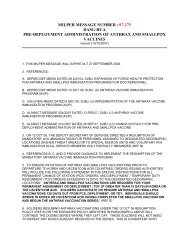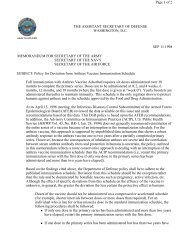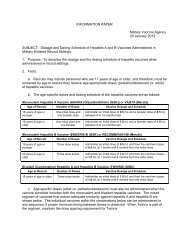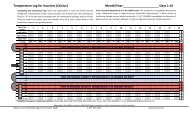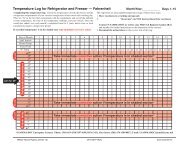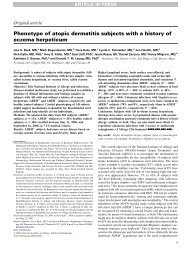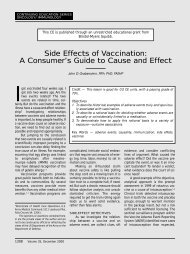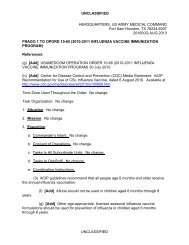Safety of anthrax vaccine: a review by the Anthrax Vaccine Expert ...
Safety of anthrax vaccine: a review by the Anthrax Vaccine Expert ...
Safety of anthrax vaccine: a review by the Anthrax Vaccine Expert ...
You also want an ePaper? Increase the reach of your titles
YUMPU automatically turns print PDFs into web optimized ePapers that Google loves.
194 j. l. sever et al.<br />
having appropriate expertise <strong>the</strong> responsibility <strong>of</strong><br />
fur<strong>the</strong>r evaluating an AE <strong>of</strong> special interest. This<br />
might be done if <strong>the</strong> reporting frequency <strong>of</strong> a certain<br />
AE seems unexpectedly high or has an unusual distribution<br />
with respect to person, place or time, if <strong>the</strong>re is<br />
emerging evidence for a causal relationship between a<br />
particular AE and o<strong>the</strong>r <strong>vaccine</strong>s, or if <strong>the</strong>re has been<br />
considerable public interest expressed in <strong>the</strong> possibility<br />
<strong>of</strong> such a relationship. In <strong>the</strong> set <strong>of</strong> VAERS reports<br />
summarized in this paper, cases <strong>of</strong> pares<strong>the</strong>sia following<br />
vaccination elicited special interest and so were assigned<br />
to <strong>the</strong> neurologist-member <strong>of</strong> AVEC (A. D. G.) for more<br />
detailed <strong>review</strong> and evaluation.<br />
RESULTS<br />
Distribution <strong>of</strong> reported AEs <strong>by</strong> person, dose number,<br />
type, concomitant illness or treatment, severity and<br />
conceivable causality<br />
Table 1 shows that <strong>the</strong> subjects <strong>of</strong> VAERS reports<br />
tended to be older and were more <strong>of</strong>ten female than<br />
all <strong>vaccine</strong>es given AVA. Although many reports<br />
lacked information regarding Service affiliation, from<br />
those which did, it appears that <strong>vaccine</strong>es in <strong>the</strong> Air<br />
Force (including those in <strong>the</strong> Air Force reserve, data<br />
not shown) were more likely than those in o<strong>the</strong>r Services<br />
to report an AE. At <strong>the</strong> time <strong>of</strong> this study, 79% <strong>of</strong><br />
AVA injections given through AVIP represented first,<br />
second, or third doses <strong>of</strong> <strong>the</strong> primary vaccination series<br />
(Table 1). A similar proportion <strong>of</strong> <strong>the</strong> reports submitted<br />
to VAERS (82.5%) concerned AEs following<br />
one <strong>of</strong> <strong>the</strong> first three doses <strong>of</strong> AVA. An observational<br />
comparison <strong>of</strong> <strong>the</strong> number <strong>of</strong> reports submitted versus<br />
total doses given suggests that <strong>the</strong> likelyhood <strong>of</strong> a<br />
report was a greatest following <strong>the</strong> first dose and<br />
tended to decrease with subsequent doses.<br />
Table 2 fur<strong>the</strong>r classifies <strong>the</strong> 602 VAERS reports<br />
with respect to (1) <strong>the</strong> type or location <strong>of</strong> <strong>the</strong> AE,<br />
(2) concomitant administration <strong>of</strong> ano<strong>the</strong>r <strong>vaccine</strong>,<br />
concurrent use <strong>of</strong> medication, and existence <strong>of</strong> a preceding/concomitant<br />
medical condition when AVA was<br />
given, (3) <strong>the</strong> severity or impact <strong>of</strong> <strong>the</strong> AE, and (4)<br />
AVEC’s assessment as to whe<strong>the</strong>r <strong>the</strong> AE may have<br />
been causally related to receipt <strong>of</strong> AVA. Each <strong>of</strong> <strong>the</strong>se<br />
factors is considered in greater detail below.<br />
Most frequently reported local and systemic AEs<br />
Nearly half <strong>of</strong> <strong>the</strong> VAERS reports cited a local (injection-site)<br />
AE, and more than three-quarters described<br />
a systemic AE, most without a concomitant local<br />
AE (Table 2). The most common local AE was<br />
inflammation (redness/swelling) <strong>of</strong> unspecified degree<br />
Table 1. Age, gender, Service affiliation, and dose number for<br />
VAERS reports and individual immunizations<br />
Characteristic % (Number) <strong>of</strong> % (Number) <strong>of</strong><br />
VAERS reports all AVA doses<br />
(N ¼ 597)* (N ¼ 1 349 327) y<br />
Age (years)<br />



